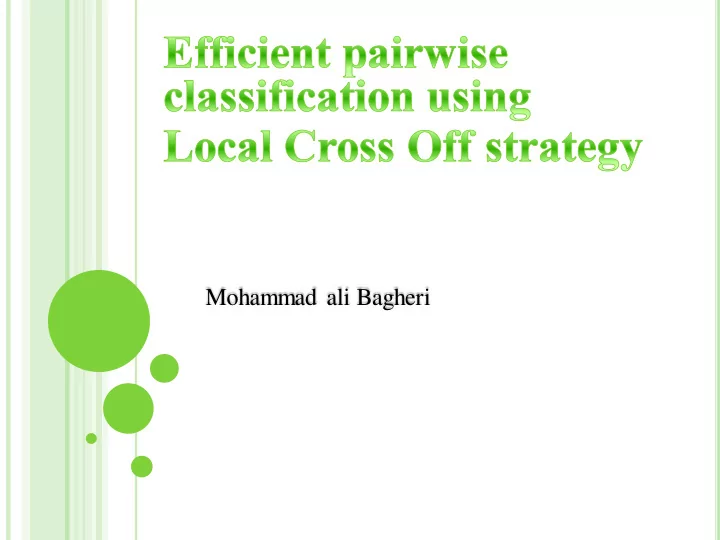

Mohammad ali Bagheri
Binary vs. Multiclass Classification Real word applications Class binarization One-versus-all (OVA) One-versus-one (OVO) Error Correcting Output Codes (ECOC) 2
Error Correcting Output Codes Idea: designing a codeword for each of the classes matrix M of size L × Nc : each cell is {-1,+1} Column ---> dichotomy classifier Row: is a unique codeword that is associated with an individual target class Sparse ECOC Adding 0 to the matrix 3
Drawbacks of OVO incompetent classifiers Suppose a problem with 4 classes new test instance belongs to C3 Training phase: 1vs2 ، 1vs3 ، 1vs4 ، 2vs3 ، 2vs4 ، 3vs4 Testing phase: h 12 → 1 h 13 → 3 h 14 → 1 h 23 → 2 h 24 → 4 h 34 → 3 Several methods has been proposed: A&O, CC, … 4
Proposed Method Training phase: build pair classifiers Test phase: for each test pattern Define Local neighborhood figures out which classes are the most frequent in those neighbors Choose relevant classifiers based on the class frequency 5
Main idea: remove the irrelevant classifiers Local Cross Off LCO-Version 1: The two most frequent classes of the nearest K neighbors in the training set of each test pattern are found one binary classifier is selected to classify test pattern LCO-Version 2: All target classes of the nearest K neighbors in the training set of each test pattern are found. Classifiers that correspond to all pairwise combinations of these classes are then nominated Majority voting 6
Validation over benchmark datasets Methods: OVO, OVA, A&O, and ECOC In modified -nearest neighbor algorithm: K=5 Base learners: Linear Support Vector Machine Multilayer Perceptron (MLP). Evaluation Accuracy based on 10-fold cross-validation fair comparison ! 7
Validation over benchmark datasets Pair accuracy comparison: 8
Validation over benchmark datasets : Statistical analysis Recommendations of Demsar: non-parametric tests General procedure: Iman – Davenport test ---> Nemenyi test Iman – Davenport test: rank competing methods for each dataset The method’s mean rank by averaging its ranks across all experiments Applying the Iman – Davenport formula 10
Validation over benchmark datasets Nemenyi test - SVM LCO_v2 sparse ECOC dense ECOC A&O 1vsAll 1vs1 11 1 1.5 2 2.5 3 3.5 4 4.5 5
Validation over benchmark datasets Nemenyi test - MLP LCO_v2 sparse ECOC dense ECOC A&O 1vsAll 1vs1 12 2 2.5 3 3.5 4 4.5 5 5.5 6
Conclusions We presented a novel strategy for pairwise classification approach to deal with multiclass problems The proposed technique is based on omitting the votes of irrelevant binary classifiers, in order to improve final classification accuracy. The proposed LCO method validated over a set of benchmark dataset 13
Conclusions The experimental evaluation shows some strong and consistent evidence of performance improvements compared to the one-versus-one, one- versus-all, A&O, and ECOC methods. The main reason behind this improvement is that the LCO approach is benefited from efficient nearest neighbor rule as a preprocessing step in pairwise structure and the strength of the other adapted powerful binary classifiers. 14
Thanks
Questions
Recommend
More recommend